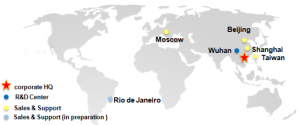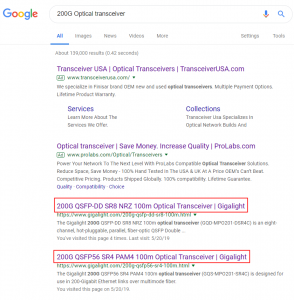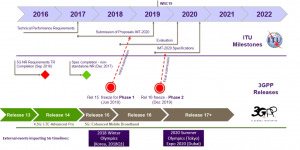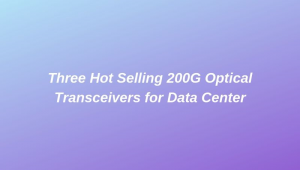With the increasing demand for high bandwidth from private cloud, public cloud data center and service providers, 25G and 100G are widely used. 200G and 400G optical devices will be successively produced and shipped from 2019. So far, most server vendors have started offering servers 25G of fiber-optic network CARDS as an I/O(input/output) option, and Ethernet’s signal transmission rate has increased from the earlier 10G to 25G, 100G or higher. While 1G, 10G and 40G currently dominate the Ethernet port market, the future demand for 25G and 100G is stronger than ever as high bandwidth is undeniably driving data centers toward greater scalability and flexibility.
Why Is 25G Coming to Data Centers?
Data centers are expanding at an unprecedented rate, driving the need for higher bandwidth connections between servers and switches. To accommodate this trend, the access network has been upgraded from 10G to 25G, providing high-density, low-cost, and low-power solutions for the connection between servers and ToR switches.
The Development History of 25G
Since its advent in 2014, Google, Microsoft, Arista Networks, Broadcom, and Mellanox have been driving the development of the 25G Ethernet standard, which is intended to enable a 25G top-shelf server network. With the increasing popularity of 25G and its rapid spread in the market, 25G will provide a comprehensive solution for the connection between server and switch in the future.
The Advantages of 25G
Before the release of 25G Ethernet standard, enterprises, operators and other data centers generally adopt the network upgrading method of 10G to 40G. With the official release of 25G Ethernet standard, 25G to 100G network upgrading method has gained more applications with the advantages of low cost, low power consumption and high density, promoting the rapid development of 100G Ethernet. Let’s take a look at the differences between 10G, 25G, 40G, and which upgrade is superior.
25G Can Provide Higher Performance Bandwidth Than 10G
In the current data center, the network connection between the server and the switch is generally between 10G and 25G. Compared with 10G, 25G is an improvement based on 10G packaging and chip technology, providing higher bandwidth and performance. The emergence of 25G enables the data center to be based on the existing network architecture without any cable interconnection, and can also support the transmission of higher rate (over 10G), meet the demand for higher bandwidth in the future network, and make the network upgrade more convenient and easy. The wiring infrastructure required for 25G and 10G transmission is basically the same, which can effectively avoid the expensive cost and the complexity of rewiring and make the network upgrade more convenient.
In addition, the 25G is similar to the 10G in that it uses a single channel of SerDes for backward compatibility, significantly reducing power consumption and costs and helping data center operators save capital and operating expenses.
Insert 25G SFP28 optical transceiver into 10G SFP+ port, what speed will we get?
Theoretically, the 25G SFP28 optical transceiver is backwards compatible with 10G SFP+ port, and its rate can reach 10G/s. However, this mode of use is not suitable for all brands of switches and optical transceivers. Considering the limitation of the fiber network card and switch port, this mode is generally not recommended.
25G Is More Suitable for High-density Requirements Than 40G
For large, high-end enterprises, the port density of the server largely determines the cost of cabling and switch infrastructure in the whole system. Therefore, compared with 40G, the cost of upgrading from 25G to 100G is relatively low. Because 25G to 100G network upgrade, the switch port is fully utilized, effectively reducing the cost of bandwidth.
It has been upgraded to a 40G network. Is it necessary to deploy a 25G network?
25G devices are expensive compared to 40G devices, so having upgraded to a 40G network, is it necessary to deploy a 25G network? Due to the cost rationalization of the 25G channel, 25G is definitely an important path to upgrade from 10G to 100G or higher in the future. If you need to increase the baud rate (signal transfer rate) or plan to upgrade the network to a higher speed (100G/200G/400G), then you must deploy the 25G network. If there is no requirement, then you do not need to deploy the 25G network.
The Prospect of 25G
At present, 25G servers and 100G switches can be seen everywhere in very large data centers. They gradually replace the earlier 10G servers and 40G switches. This network upgrade increases the throughput of the whole system by 2.5 times and reduces the incremental cost of equipment. As the Ethernet industry continues to innovate and lay the foundation for higher rate research and development, the 25G-100G upgrade model has become an important path for data centers.
25G Offers More Possibilities for 50G
As we all know, 25G can provide 2.5 times the bandwidth compared with 10G, and 50G can provide 1.25 times the bandwidth compared with 40G in the future. Currently, 50G has been proposed as the basis for 100G,200G, 400G network upgrade, but the implementation of 50G Ethernet standard still needs some time.
25G will provide more possibilities for 50G, as the implementation of 50G Ethernet can be based on two 25G channels, so it will be an alternative to the current use of four 10G channels up to 40G, reducing the cost of network equipment in the data center by reducing channel deflection. In the future, the network upgrade path may evolve from the traditional 10G-40G-100G to 10G-25G-50G-100G. In any case, upgrading a data center from multiple 25G channels to a 50G or 100G network will be simpler and more economical.
25G Lays the Foundation for 200G and 400G Network Upgrade
The 25G,50G,100G network architecture offers greater flexibility and is often used as a solution for large data centers, paving the way for later 200G/400G upgrades. At present, high-end enterprises and large data centers are shifting towards this, effectively promoting the implementation of large data centers and the interconnection between data centers. Nowadays, more and more suppliers in the market are engaged in the research and development of 200G and 400G optical devices, some of which have been successfully put into use. The implementation of 100G Ethernet is based on the development of 25G/50G. Similarly, the future network upgrade of 200G and 400G will be based on 100G. The following table lists the paths from 25G/50G/100G to 200G/400G.
Conclusion
The need for higher speed and performance in future data centers will never cease. Looking back at the evolution of 25G over the past few years, you can see that the emergence of 25G is a milestone in the next generation of data center network bandwidth and channel capacity expansion. The 25G to 100G network upgrade overturns the traditional 10G-40G network and improves the efficiency of the data center by providing higher bandwidth and port density, reducing power consumption and cost. It lays a solid foundation for the 200G/400G upgrade. Let’s wait and see how the continuous development and innovation of Ethernet will promote the new round of changes in the data center.
Gigalight supplies one-stop data center optical transceivers for 40G/50G/100G/200G/400G Ethernet interconnections. Gigalight has been keeping pace with the industry’s mainstream technology, focusing on boutique development to help users create a high-capacity, high-reliability, large cache cloud data center network. In the future, Gigalight will bring more innovative products to customers.








